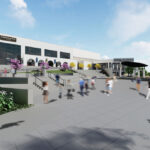Two thousand pink-yarn pompoms. An intricately embroidered garbage bag. A giant pack of birth control pills made of pastel tissue paper.
All these and additional works of art by local women artists are on display at the Women’s Museum of California, located in the Joe and Vi Jacobs Center in Southeast San Diego.
The current exhibit is titled, “Crafting Feminism: Textiles of the Women’s Movement.”
The museum, which celebrates the struggles and achievements of women, opened its newest location on Euclid Avenue in mid-June. (Its collections of papers and artifacts are stored at the San Diego History Center in Balboa Park.)
“Some women left our opening crying,” said Felicia Shaw, standing in the 1,700-square-foot space where the walls are covered with art fashioned from paint, fabric, paper, thread, yarn and plastic bags. “(These women) never had the occasion to be in a space dedicated to telling their stories. It’s important to find yourself without having to sift through lots of other stuff.”
The museum is one of five in the country dedicated to women’s history, and the Smithsonian has one on the drawing board, according to Shaw.
The museum had its origins with San Diegan Mary Maschal (1924-1998), a historian, lobbyist and lecturer who had an extensive collection of artifacts that told of the history and experiences of women, especially in San Diego and the state.
“She was a self-taught historian who was concerned with the lack of representation of women,” Shaw said.
In 1995, Maschal opened her large Victorian home in the Golden Hill neighborhood so the public could see her collection.
“It wasn’t long before she outgrew her home. The collection was then moved to a teeny space, but at least it wasn’t her home.”
In 2001, the museum co-founded the San Diego County Women’s Hall of Fame, and in 2011, moved to the Arts District in Liberty Station (the Naval Training Center from 1923 to 1997).
The pandemic closed this location in 2020, but also provided an opportunity.

“It gave us a chance to examine whether the museum was as relevant as it could be,” Shaw said. “We were steeped in the suffrage movement and seemed to be stuck there.
“We are now in the third wave of the women’s movement, with the #MeToo movement, gender equality, LGBTQ equality.”
The museum also wanted to reach more locals.
“Liberty Station is pretty touristy, so we didn’t have a lot of San Diegans coming through, especially those of color and low-income.”
The Jacobs Center, in an ethnically diverse area, seemed to fulfill these needs and present an opportunity.
“We want to spend the next six months growing our visitors and members,” Shaw said. “We could be a cultural anchor for the area.”
Admission is free from 11 a.m. to 4 p.m. on first Saturdays.
The museum hosts a free, monthly, 60-minute walking tour of Balboa Park to explore the role that women played in establishing the park and staging the 1915 California-Panama Exposition. The next tour is 10 a.m. August 7.
Check it out: Women’s Equality Day Festival on Aug 27.
North County residents can reach the museum via the Coaster. At the Santa Fe Station (end of the line), transfer to the San Diego Trolley’s Blue Line, then to the Orange Line at the 12th and Imperial station. Trolleys run every seven minutes during peak time; every 30 minutes otherwise.
For more photos and discussion, visit www.facebook.com/elouise.ondash.



